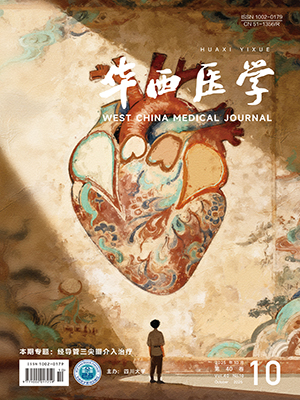| 1. |
戴萌娜, 袭燕, 尹文强, 等. 中国 2005—2019 年 0~14 岁儿童肺炎死亡趋势分析. 中国学校卫生, 2021, 42(9): 1411-1414.
|
| 2. |
谢婷婷, 罗璨, 李琳. 2018—2021 年江苏省 5 岁以下儿童肺炎死亡特征分析. 中国妇幼保健, 2024, 39(10): 1847-1850.
|
| 3. |
Kim SR. Viral infection and airway epithelial immunity in asthma. Int J Mol Sci, 2022, 23(17): 9914.Kim SR. Viral infection and airway epithelial immunity in asthma. Int J Mol Sci, 2022, 23(17): 9914.
|
| 4. |
Tian J, Shang B, Zhang J, et al. T cell immune evasion by SARS-CoV-2 JN.1 escapees targeting two cytotoxic T cell epitope hotspots. Nat Immunol, 2025, 26(2): 265-278.
|
| 5. |
茅松, 刘光陵, 夏正坤, 等. 儿童支气管哮喘变应原检测与年龄、性别的关系探讨. 实用医学杂志, 2011, 27(18): 3366-3368.
|
| 6. |
熊振宇, 张娟. 多重感染肺炎患儿临床与病原学研究. 开封医专学报, 2000, 19(2): 28-29.
|
| 7. |
池细俤, 高世华, 张忠源, 等. 急性呼吸道感染常见病毒的流行病学分析. 中国感染控制杂志, 2019, 18(4): 320-325.
|
| 8. |
王紫荆, 方剑, 胡小林, 等. 儿童非典型病原体肺炎病原及流行病学特征分析. 实用医院临床杂志, 2020, 17(6): 156-158.
|
| 9. |
彭献华, 李冰冰, 李晓琳, 等. 2021—2022 年某医院呼吸道感染患儿肺炎支原体感染流行特征. 中华医院感染学杂志, 2023, 33(18): 2851-2854.
|
| 10. |
阎进晓, 郭静娜, 孙苗, 等. 阿奇霉素序贯疗法联合复可托对小儿肺炎支原体感染的疗效及 GSH-Px、ICAM-1 水平的影响分析. 贵州医药, 2022, 46(10): 1542-1544.
|
| 11. |
Liccioli G, Filippeschi C, Giovannini M, et al. Mycoplasma pneumoniae-associated mucocutaneous disease in children: a case series with allergy workup in a tertiary care paediatric hospital. Clin Exp Allergy, 2021, 51(5): 740-744.
|
| 12. |
卢红霞, 黄晗, 梁利红, 等. 阿奇霉素联合特布他林对支原体肺炎患儿体液免疫及炎症水平的影响. 罕少疾病杂志, 2024, 31(4): 24-26.
|
| 13. |
Liese JG, Schoen C, van der Linden M, et al. Changes in the incidence and bacterial aetiology of paediatric parapneumonic pleural effusions/empyema in Germany, 2010-2017: a nationwide surveillance study. Clin Microbiol Infect, 2019, 25(7): 857-864.
|
| 14. |
林野, 龚政, 陆红云, 等. 江苏省苏州市某医院儿童肺炎支原体分型及临床特征. 中国热带医学, 2021, 21(11): 1098-1102.
|
| 15. |
Thaulow CM, Lindemann PC, Klingenberg C, et al. Epidemiology and antimicrobial susceptibility of invasive bacterial infections in children-A population-based study from Norway. Pediatr Infect Dis J, 2021, 40(5): 403-410.
|
| 16. |
蒋娟, 石远滨. 儿童社区获得性肺炎细菌病原分布及细菌耐药情况分析. 世界最新医学信息文摘(电子版), 2020, 20(43): 1-2, 5.
|
| 17. |
Oumei H, Xuefeng W, Jianping L, et al. Etiology of community-acquired pneumonia in 1500 hospitalized children. J Med Virol, 2018, 90(3): 421-428.
|
| 18. |
郑圣坤, 卓志强. 儿童肺炎流感嗜血杆菌合并肺炎支原体感染的临床特征. 中国医学创新, 2021, 18(19): 10-14.
|
| 19. |
Nørskov-Lauritsen N. Classification, identification, and clinical significance of Haemophilus and Aggregatibacter species with host specificity for humans. Clin Microbiol Rev, 2014, 27(2): 214-240.
|
| 20. |
Levine OS, Liu G, Garman RL, et al. Haemophilus influenzae type B and Streptococcus pneumoniae as causes of pneumonia among children in Beijing, China. Emerg Infect Dis, 2000, 6(2): 165-170.
|
| 21. |
钟莹. 儿童肺炎病原学临床特点回顾性分析. 南昌: 南昌大学, 2019.
|




